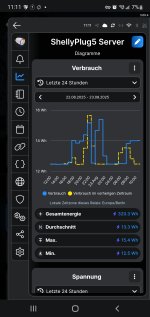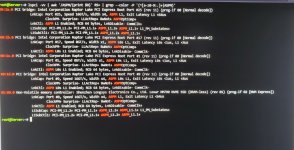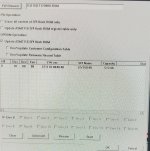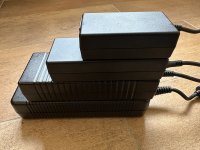Hallo Zusammen,
ich hab hier die letzten Wochen viel gelesen und gelernt, erstmal danke dafür.
Am Ende ist es eine Konfiguration geworden, die ich hier nicht gesehen (oder übersehen) habe.
Daher wollte ich meine Erfahrungen mit euch teilen:
Unraid 7.14 Server/NAS Build:
Intel i3-14100
ASUS PRIME B760M-A D4-CSM
2x 8GB DDR4 3600 @ 2133 MHZ (Corsair Vengeance)
Be Quiet! Pure Power 13 M 550w
Keine VMs/Docker
Festplatten:
3.5" = 1x 8TB WD Red Plus, 2x 4TB WD Red Plus, 1x 2TB WD Green
M.2 Nvme = SAMSUNG NVMe SSD 970 EVO, 1 TB
Idle Verbrauch:
12W-13W, gemessen mit HMIP PSM im 2 Minuten Interval.

Einstellungen:
- Die üblichen ASPM Settings im Bios, unnötige Onboard Devices + CPU Turbo deaktiviert
- Powertop Auto
- ASPM Helper -> Realtek 2.5G NIC (RTL8125) ASPM Mode 2 erzwungen (mit Stock Treiber)
Beobachtungen:
Ohne ASPM Helper bin ich nicht über C3 hinausgekommen, da ASPM für die RTL8125 auf disabled verharrte.
Mit erzwungenem ASPM arbeitet das System nahezu vollständig in C8 State.
Alle anderen Geräte haben keine Probleme gemacht. In beiden M.2 Slots war C8 möglich.
Woher die punktuellen Spikes auf 18W kommen, muss ich noch rausfinden..
Ich habe mein Unraid vom alten System "mitgenommen", sprich einfach USB Stick ins neue System.
Vermutlich ist da irgendeine Konfig noch unsauber.
ich hab hier die letzten Wochen viel gelesen und gelernt, erstmal danke dafür.
Am Ende ist es eine Konfiguration geworden, die ich hier nicht gesehen (oder übersehen) habe.
Daher wollte ich meine Erfahrungen mit euch teilen:
Unraid 7.14 Server/NAS Build:
Intel i3-14100
ASUS PRIME B760M-A D4-CSM
2x 8GB DDR4 3600 @ 2133 MHZ (Corsair Vengeance)
Be Quiet! Pure Power 13 M 550w
Keine VMs/Docker
Festplatten:
3.5" = 1x 8TB WD Red Plus, 2x 4TB WD Red Plus, 1x 2TB WD Green
M.2 Nvme = SAMSUNG NVMe SSD 970 EVO, 1 TB
Idle Verbrauch:
12W-13W, gemessen mit HMIP PSM im 2 Minuten Interval.
Einstellungen:
- Die üblichen ASPM Settings im Bios, unnötige Onboard Devices + CPU Turbo deaktiviert
- Powertop Auto
- ASPM Helper -> Realtek 2.5G NIC (RTL8125) ASPM Mode 2 erzwungen (mit Stock Treiber)
Beobachtungen:
Ohne ASPM Helper bin ich nicht über C3 hinausgekommen, da ASPM für die RTL8125 auf disabled verharrte.
Mit erzwungenem ASPM arbeitet das System nahezu vollständig in C8 State.
Alle anderen Geräte haben keine Probleme gemacht. In beiden M.2 Slots war C8 möglich.
Woher die punktuellen Spikes auf 18W kommen, muss ich noch rausfinden..
Ich habe mein Unraid vom alten System "mitgenommen", sprich einfach USB Stick ins neue System.
Vermutlich ist da irgendeine Konfig noch unsauber.










